Whether you’re a seasoned green thumb or a novice gardener, understanding the signs and symptoms of these pests and taking action promptly can save your garden from destruction. Welcome to the world of garden pests, where even the most idyllic of outdoor spaces can fall victim to a silent invasion.
These pesky creatures come in all shapes and sizes, from tiny aphids to larger moles, and can wreak havoc on your carefully tended plants and vegetables. But fear not, for there are ways to prevent and control these unwelcome guests. In this article, we will be taking a look at the 35 most common pests that plague gardens and sharing methods for getting rid of them.
The basics of pest control in your garden
Let’s start with the basics. You may be wondering, what is the most common garden pest? Well, the answer is not as straightforward as you might think, as there are dozens of different pests that can afflict your garden. Some of the most common include aphids, caterpillars, whiteflies, snails, and slugs.
So how do you identify pest in your garden?
The first step is to keep a close eye on your plants, looking for any signs of damage or unusual activity. Some pests, like aphids and caterpillars, can be seen with the naked eye, while others, like spider mites, are much smaller and require a magnifying glass to detect.
What is the hardest pest to control?
Again, this is a tough question to answer, as different pests may require different methods of control. Some pests, like slugs and snails, can be deterred with physical barriers, while others, like aphids, can be controlled with insecticidal soap or neem oil.
So, what kills insects the most?
Chemical pesticides are often the most effective way to kill insects, but they can also be harmful to beneficial insects and the environment. It’s important to use pesticides judiciously and follow the instructions carefully.
But what if you’re looking for a natural bug killer?
There are many natural remedies that can be effective at controlling pests in your garden. For example, planting marigolds or other companion plants can help repel pests, while introducing predators like ladybugs or praying mantises can help control populations.
And what about vinegar as a bug killer?
While vinegar has many household uses, including cleaning and disinfecting, it is not a particularly effective insecticide. Some pests may be deterred by the smell of vinegar, but for the most part, it is not a reliable solution for pest control.
Finally, how do you keep bugs out of your garden?
There are a few basic steps you can take to minimize the risk of pest infestations. Keeping your garden clean and free of debris can help eliminate hiding spots for pests, while regular watering and fertilization can keep your plants healthy and better able to resist attacks. Additionally, rotating your crops and planting a variety of different plants can help discourage pests from becoming established in your garden.
35 Common garden pests and how to get rid of them
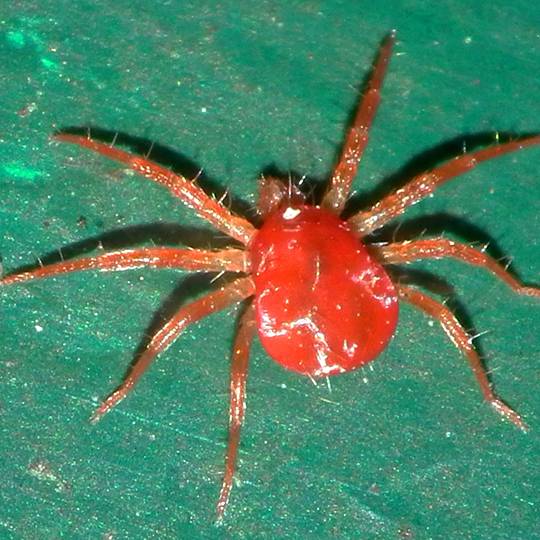
Red Spider Mites
Appearance: They’re difficult to see with the naked eye due to their size (1/50th of an inch), but you can use a magnifying glass to confirm that it’s them. They are red, yellow, or brown with 8 legs.
Origin: Red spider mites are thought to have originated in South America in the mid-20th century, and have spread gradually since then.
Damage: They like to strike during hot, dry periods above 20 degrees C. They pierce the leaves, draining out the sap, which leaves yellow or white speckles behind. In order to navigate the host plant quickly, they build webs similar to those of spiders. The leaf will gradually turn yellow and die. If left unchecked, the mites will defoliate and kill the entire plant.
Common host plants: Red spider mites are not very picky about the plants they’re hungry for. They are most known for attacking the nightshade group of plants which includes potatoes, tomatoes, and eggplant. They also attack beans, strawberries, some flowers, and orchard trees.
Neutral predators: Many insects feed on spider mites, including ladybugs, lacewings, and predatory mites. This is why you shouldn’t use pesticides to solve a spider mite problem – you will end up eliminating the bugs which are your allies in this situation! Spiders also like mites as a crunchy snack.
How to get rid of them:
Confirm that you have spider mites by checking for spots of discoloration on the leaves. Another thing you can do is hold a white sheet of paper under a leaf and tap the leaf – if you see little specks fall onto the sheet then it’s likely spider mites.
You can wash the mites off the plant with a strong jet of water. You have to hit the undersides of the leaves where the mites are in order for this to work, which can make it time-consuming. You can also use mite killers that you can find at a plant nursery.
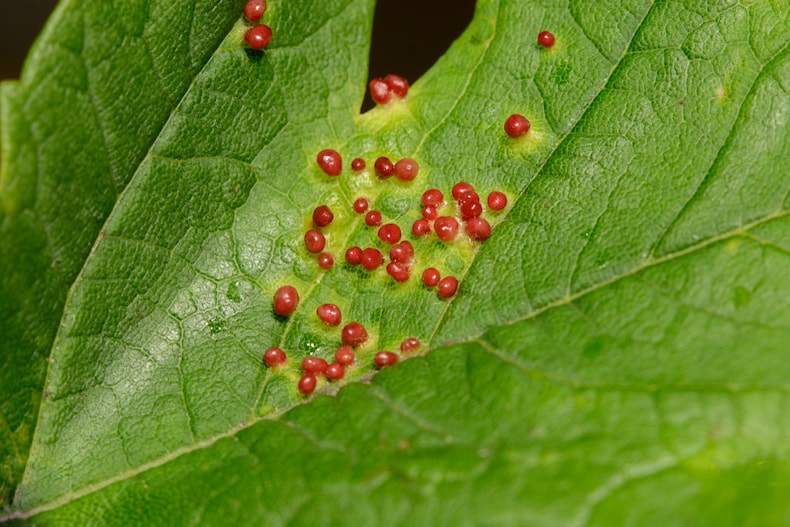
Gall Mites
Appearance: Gall mites are so small that they’re invisible to the naked eye. Their presence is indicated by the galls they form.
Origin: Galls are formed by multiple different insects and mites, and each gall-producing pest leaves its own distinctive type of gall.
Damage: Galls are growths that form as a gall mite feeds on the plant. As it feeds, it leaves behind a hormone that causes the surrounding plant tissue to swell up.
Common host plants: Gall mites are known to cause galls on a variety of plants, including fruit trees, roses, and maples.
Neutral predators: Predatory mites and ladybugs are natural enemies of gall mites.
How to get rid of them: In most cases, no action is required since galls in small numbers don’t harm plants. Certain types of galls are more harmful than others – some examples are raspberry leaf and bud mites, fuschia gall mites, and blackcurrant big bud mites. If you find galls on your plants, it’s best to find out which insect is causing them and go from there.

Bagworm
Appearance: Bagworms are caterpillars that create a protective cocoon around themselves using silk and plant material. The cocoons look like small, brown bags hanging from branches. The bagworms themselves are short, moon-shaped worms, similar to cutworms and grubs.
Origin: Bagworms are found in many parts of the world, usually forested areas and urban centers with lots of trees.
Damage: These pests can defoliate entire trees and shrubs if left unchecked.
Common host plants: Bagworms attack trees and shrubs. Their preferred varieties are juniper, arborvitae, pines, spruces, apple trees, ballwood, elms, maples, oaks, poplars, and willows.
Neutral predators: Birds and parasitic wasps are the primary predators of bagworms. They limit the populations of bagworms in the wild, but in urban areas, they are not usually present, so bagworms can take over more easily.
How to get rid of them: Handpicking and destroying the bags is the best way to get rid of them. Be sure to destroy them, since they can still hatch even after being picked off the tree. Insecticidal sprays can also be used to control infestations.
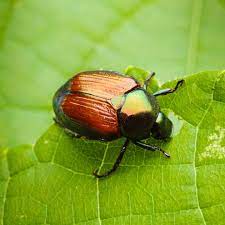
Japanese Beetles
Appearance: Japanese beetles are a type of scarab beetle, measuring about ½ inch in length. They have metallic green bodies with copper-colored wing covers. They usually feed in small groups.
Origin: Japanese beetles are native to Japan, but they made their way to North America in the early 1900s and are now widespread all over the continent.
Damage: They eat the soft tissues around the veins of leaves, leaving behind a “skeletonized” appearance. They also eat flowers and other parts of the plants. As grubs, they live in the ground and feed on the roots of not only garden plants or trees (like the Laceleaf Japanese Maple), but of lawn grass as well.
Common host plants: Japanese beetles are known to attack over 300 types of plants, including roses, grapes, beans, raspberries, and fruit trees.
Natural predators: Birds, parasitic wasps, spiders, and assassin bugs all feed on Japanese beetles.
How to get rid of them: pick them off by hand and drop them into a can of water with dish soap – this will drown them. You can also spray neem oil onto the plants, which will stop the eggs from hatching – however, don’t use neem oil near streams or lakes since it’s harmful to fish and other aquatic life. Insecticides can also be used – consult a nursery to see which chemicals are approved in your area.
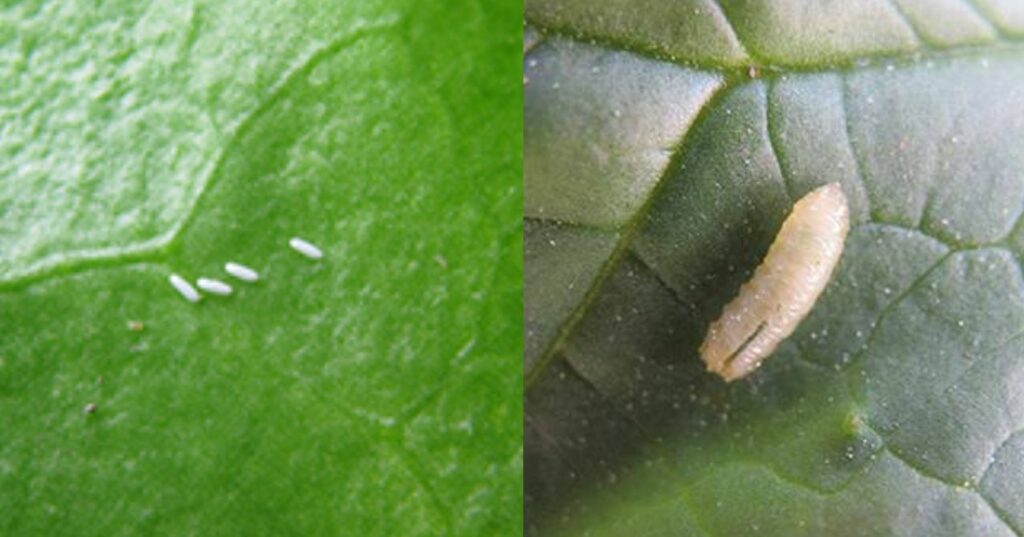
Leaf Miner
Appearance: Leaf miners are the larvae of certain types of black flies. Their appearance depends on their type – spinach leafminers are white and carrot-shaped without visible legs or heads. In contrast, vegetable leafminers have a yellow-green cylindrical body, also without legs or heads.
Origin: The term “leaf miner” refers to a large group of fly species that can be found worldwide.
Damage: Leaf Miners eat their way through the leaf tissue, leaving behind squiggly yellow tunnels. They don’t stunt the growth of the plants but they do kill the leaves.
Common host plants: Spinach leafminers like to eat the leaves of spinach, Swiss chard, tomatoes, cucumbers, and celery. For vegetable leafminers, it’s beans, peas, nightshade plants, squash, watermelons, beets, onions, and lettuce.
Natural predators: Ants and parasitic wasps are natural enemies of leaf miners.
How to get rid of them: Remove leaves with leaf miner damage. Also, it’s best to help breed natural predators like parasitic wasps rather than resort to pesticides.
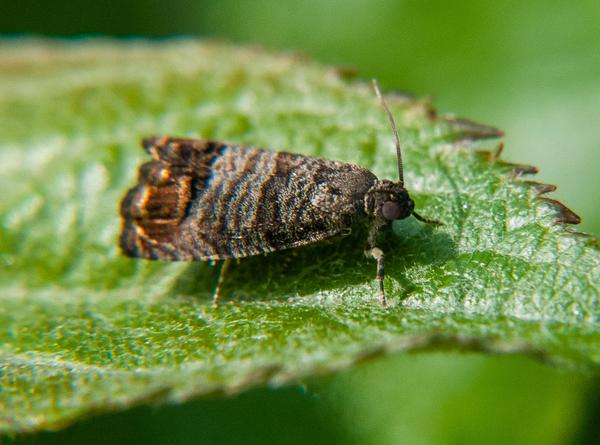
Codling Moth
Appearance: Codling moths are small, brownish-gray moths with copper-colored markings on their wings. Adult moths are about 3/8 of an inch long.
Origin: Codling moths are native to Europe, but they have made their way to many parts of the world.
Damage: These pests lay their eggs in developing apples and pears, and the resulting larvae feed on the fruit. They leave brown spots that lead deep into the fruit.
Common host plants: Codling moths primarily attack apple and pear trees.
Natural predators: Birds are the most effective predator of codling moths. Parasitic wasps also make quick work of them.
How to get rid of them: Be sure to clean up any apples on the ground after harvest. Inspect your harvest for moths to make sure they don’t use your storage facility as shelter. You can hang pheromone traps in your trees called delta or wing traps, which are tent-shaped pieces of wax paper coated with tanglefoot that attracts and traps the insects.
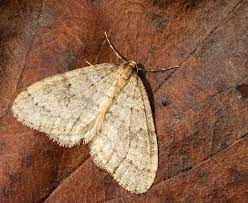
Winter Moth
Appearance: Winter moths are small, grayish-brown moths with a wingspan of about 1 inch.
Origin: Winter moths are native to Europe and Asia, and they are now common in some regions of North America.
Damage: They defoliate the leaves of their host trees.
Common host plants: Winter moths are known to attack a wide variety of trees, including oak, maple, and apple.
Natural predators: Birds, parasitic wasps, ground beetles, and shrews all feed on winter moths.
How to get rid of them: Applying dormant oils during late winter or early spring is a common treatment for winter moths.
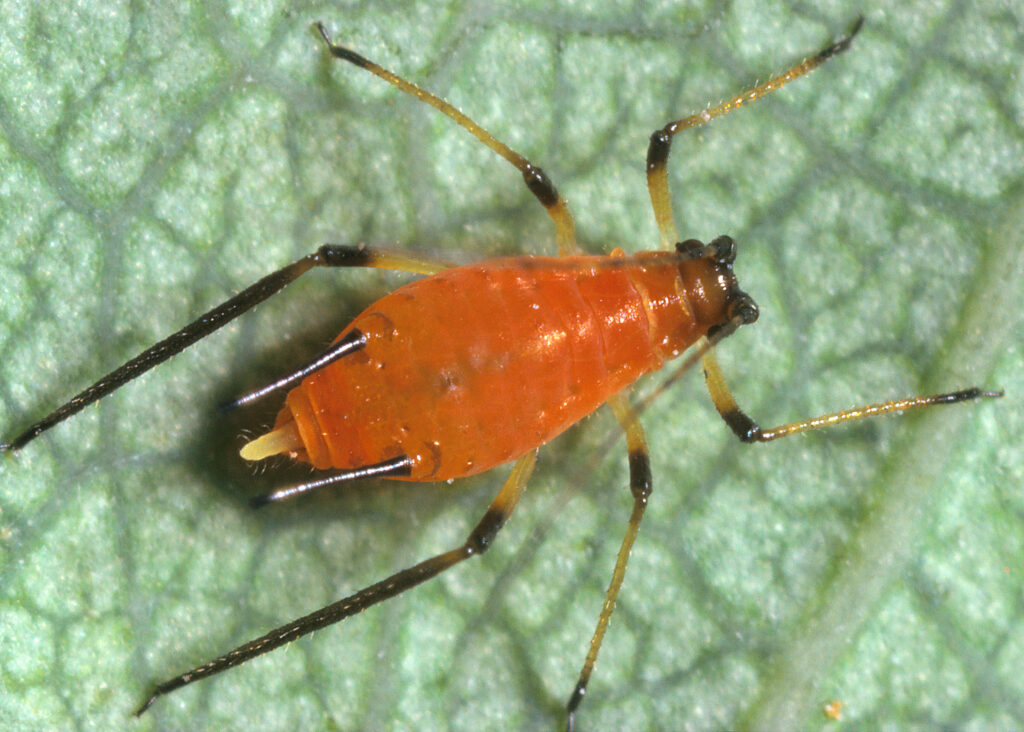
Aphids
Appearance: Aphids are small, pear-shaped insects that can be green, yellow, or black. They have black legs and long antennae.
Origin: Aphids are found all over the world, and are one of the most common garden pests.
Damage: Aphids feed on the liquids and sap inside the plants. This causes stunted growth and severely weakens the host plants.
Common host plants: Aphids feed on just about every type of cultivated crop, including vegetables
Natural predators: Ladybugs, lacewings, and parasitic wasps all consider aphids a tasty snack.
How to get rid of them: You can control aphids by spraying the plants with a strong stream of water to knock them off, or by applying insecticidal soap or neem oil. Ants like to farm aphids, so if you have an aphid problem then get rid of the ants as well.
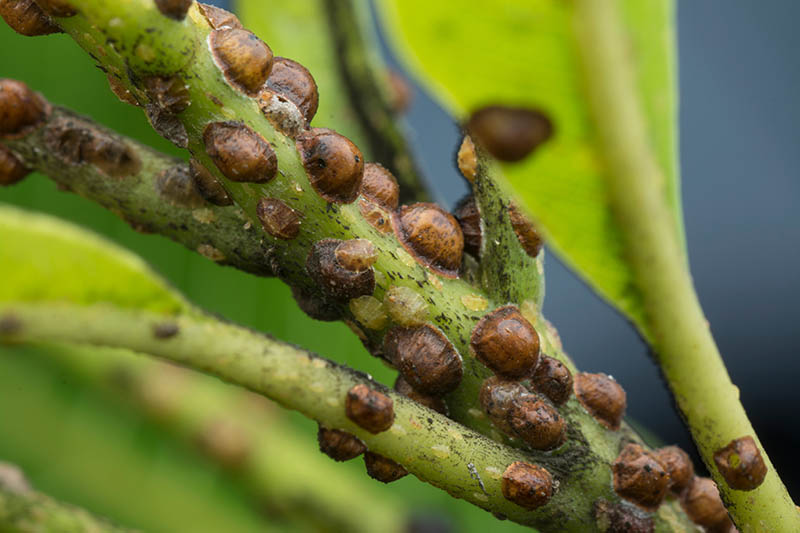
Scale Insects
Appearance: At first glance, scale insects look like bacterial infections, since they look like a glob and don’t move. They either have a hard shell which acts as armor, or they have a soft body surrounded by a waxy film. Colors range from yellow, orange, brown, tan, or white, depending on the species. They’re found in clusters on the stems, leaf joints, and the undersides of leaves.
Origin: Scale insects originated in the age of the dinosaurs. In the present day, they live in most regions of the world, with different species being native to different regions.
Damage: Scale insects feed on the sap of plants, causing wilting, yellowing, and stunted growth. Soft-bodied varieties secrete a sticky substance called honeydew that can attract other pests.
Common host plants: They infest both trees and non-woody plants. Some of their preferences are fruit trees, ornamental trees, shrubs, houseplants, vegetables, and vining plants.
Natural predators: Ladybugs, lacewings, soldier beetles, and parasitic wasps can be introduced to control scale insects.
How to get rid of them: You can control scale insects by scraping them off with a soft brush, applying horticultural oil or insecticidal soap, or releasing their natural predators listed above.
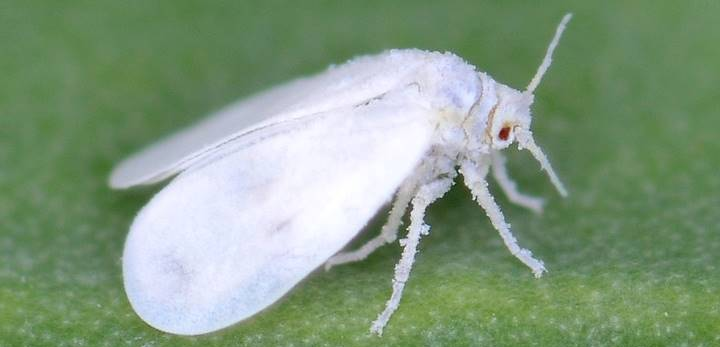
Whitefly
Appearance: Whiteflies look like small moths with triangular-shaped bodies. They’re often found in clusters on the undersides of leaves, and they’ll scatter if you shake the plant.
Origin: Whiteflies are found in warmer regions where they can safely overwinter. In USDA zones 7 and colder, they can’t survive the winters outdoors, but they are able to survive in greenhouses and may become seasonal pests in these regions.
Damage: Whiteflies feed on plant sap, which kills the leaves and stunts the plant’s growth. Like aphids and other pests, they leave behind traces of honeydew, which attracts other pests and can cause fungal infections.
Common host plants: Whiteflies feed on a wide variety of plants, especially warm-weather vegetables like tomatoes, eggplant, peppers, and okra. Some species like ornamental flowers, citrus trees, and members of the cabbage family.
Natural predators: Ladybugs, spiders, green lacewing larvae, hummingbirds, and dragonflies all feed on whiteflies.
How to get rid of them: You can blast plants with a stream of cold water to scatter the flies and dislodge the eggs. You can also spray the plants with a solution of water and dish soap. It’s not recommended to use insecticides since they will also kill the natural enemies of whiteflies.
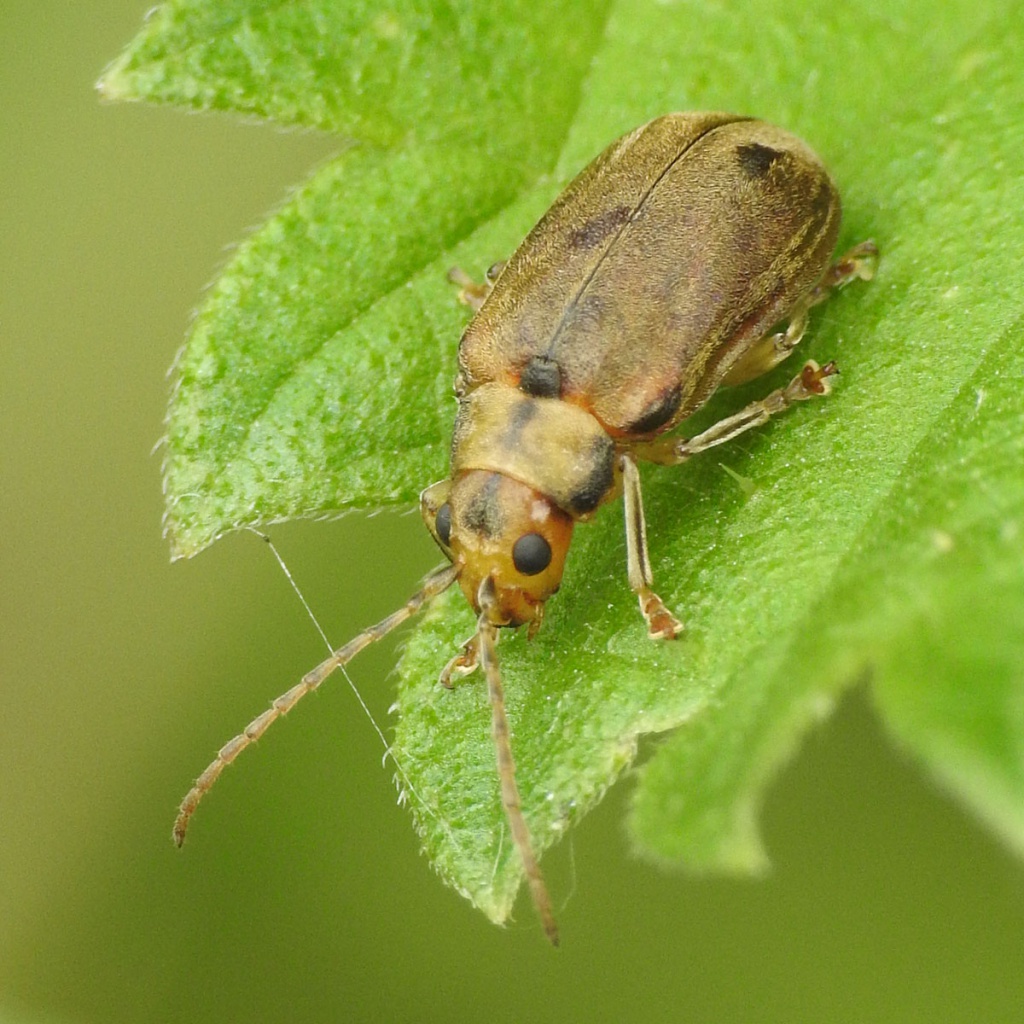
Viburnum Beetle
Appearance: Viburnum beetles are small, bright green insects that measure about 1/4 inch long. They look similar to Japanese beetles with a shiny, metallic appearance and long antennae.
Origin: Viburnum beetles are native to Europe and Asia, but they were first detected in North America in 1947 and they are now widespread on the continent.
Damage: Viburnum beetles feed on the leaves of viburnum shrubs. They feed on the soft parts of leaves, leaving a skeletonized pattern similar to that left by Japanese beetles.
Common host plants: Viburnum beetles feed exclusively on viburnum shrubs.
Natural predators: General predatory insects like lady beetles and soldier bugs feed on both larvae and adults.
How to get rid of them: You can control viburnum beetles by handpicking them off the plant. Avoid using general insecticides, which kill beneficial insects.
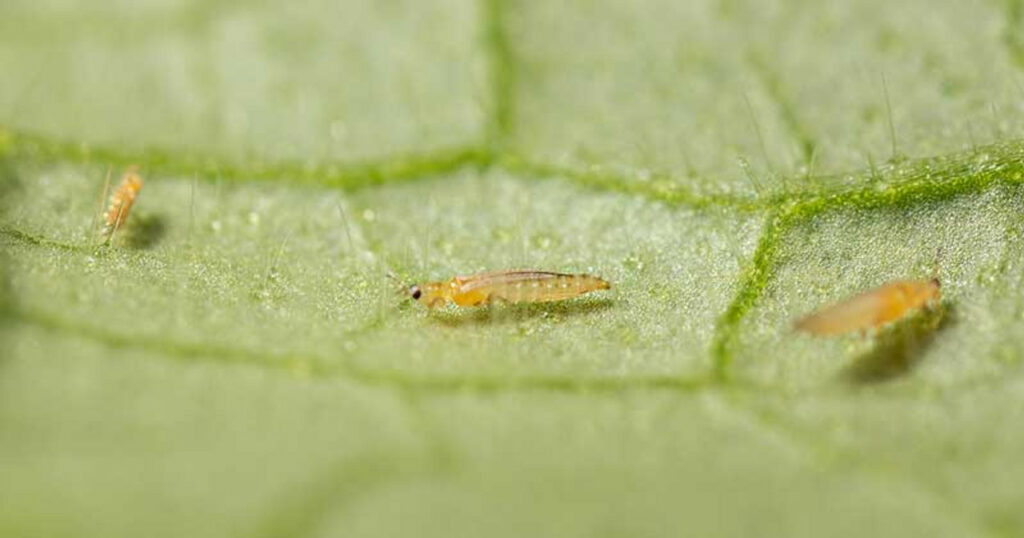
Thrip
Appearance: Thrips are tiny, slender insects that are difficult to see with the naked eye. They are about the thickness of a sewing needle and black, brown, or yellow in color.
Origin: Thrips are found all over the world and can be either beneficial or harmful to plants, depending on the species.
Damage: Thrips bite into plant leaves and suck out the sap. This discolors the leaves and causes the plant to wilt and eventually die. They leave a black residue behind on the undersides of the leaves.
Common host plants: Thrips attack both garden vegetables and decorative flowers such as petunias, gerbera daisies, corn plants or Cattleya Orchids.
Natural predators: Ladybugs, lacewing, and minute pirate bugs all prey on thrips.
How to get rid of them: Introducing predatory insects is a great way to control them without using chemicals. Make sure to remove plant debris from the garden, especially onion wraps.
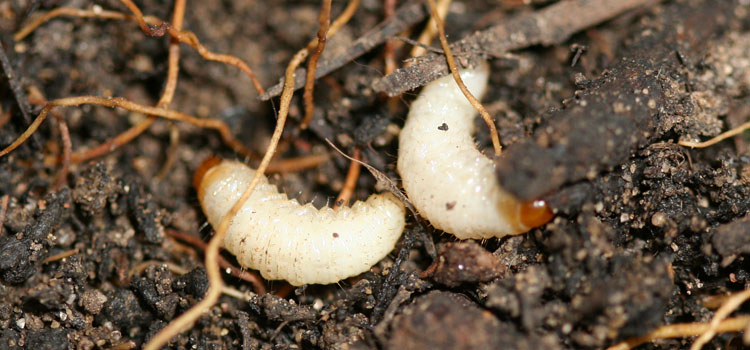
Vine Weevil Larvae
Appearance: Vine weevil larvae are white, C-shaped grubs with brown heads and no legs. They are around 10mm long.
Origin: Vine weevils are native to Europe, but they have found their way to the Americas, Australia, New Zealand, and Japan.
Damage: Vine weevil larvae feed on plant roots, which causes the plants to wilt and eventually die. They are particularly harmful to potted plants.
Common host plants: Vine weevil larvae eat the roots of trees and flowers.
Natural predators: Weevil larvae are vulnerable to ground beetles and birds.
How to get rid of them: You can purchase beneficial nematodes to feed on the larvae of these bugs. If this doesn’t work then you may need to resort to pesticides.
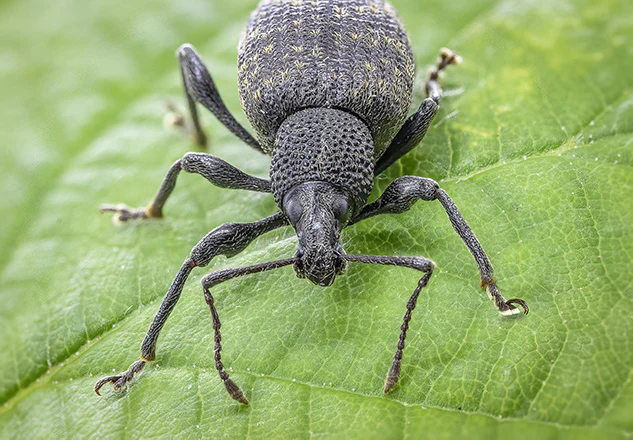
Adult Vine Weevil
Appearance: Adult vine weevils are black or dark brown flightless beetles that have a distinctive snout at the head.
Origin: Vine weevils are native to Europe, but they have found their way to the Americas, Australia, New Zealand, and Japan.
Damage: Adult vine weevils feed on the leaves of plants, leaving notches along the edges. They are particularly harmful to potted plants.
Common host plants: Adult vine weevils attack a wide variety of plants, including shrubs, trees, vegetables, and ornamentals.
Natural predators: Ground beetles and birds love to feed on adult vine weevils. They’re more vulnerable than their larvae since they’re not protected by the soil.
How to get rid of them: Since they can’t fly, weevils can be stopped by placing physical barriers or sticky pads around plant stems. Diatomaceous earth is also an option.
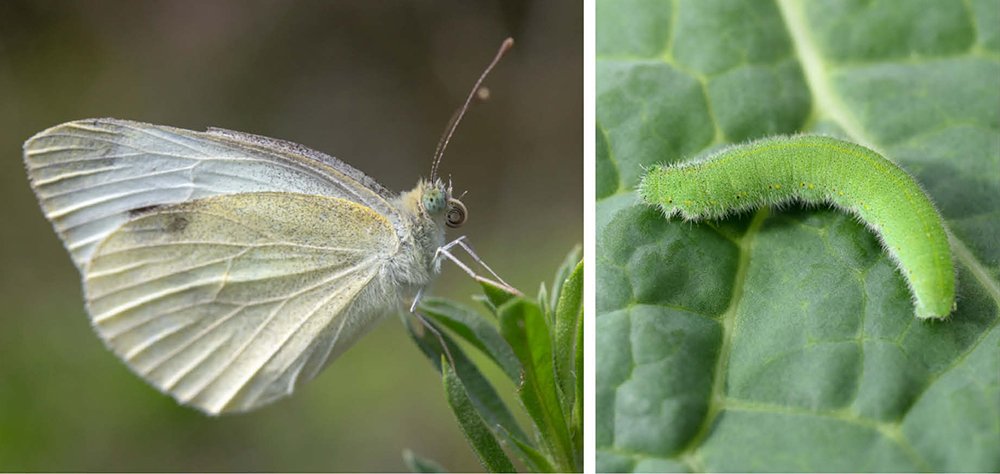
Cabbage White Caterpillars
Appearance: Cabbage white caterpillars are green and yellow caterpillars with a velvety appearance. They have a distinct yellow stripe down their backs and are around 4cm long.
Origin: Cabbage white caterpillars are native to Europe, but they are common in North America as well.
Damage: Cabbage white caterpillars feed on plant leaves, leaving holes all over.
Common host plants: Cabbage white caterpillars mostly attack plants in the cabbage (brassica) family.
Natural predators: Ladybugs and parasitic wasps feed on cabbage white caterpillars.
How to get rid of them: You can prevent them from reaching the plants using row covers. Using companion plants such as herbs and nasturtiums also helps keep the caterpillars away.
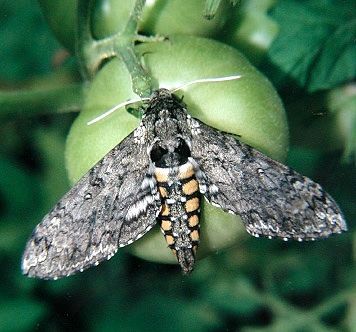
Tomato Moth
Appearance: Tomato moths are small, brown moths with patterns on the wings. Their larvae look like little white cylinders.
Origin: Tomato moths are native to South America, but they’re also common in North America, Europe, and Asia.
Damage: Tomato moths feed on the leaves and fruit. They can easily defoliate whole plants.
Common host plants: Tomato moths feed on the nightshade family of plants, including tomatoes, peppers, and eggplants.
Natural predators: Some natural predators of tomato moth include birds, spiders, and parasitic wasps.
How to get rid of them: Use row covers to prevent adult moths from laying eggs on plants. Handpicking and crushing the larvae can also be effective. Insecticidal soaps or neem oil can be used to control infestations.
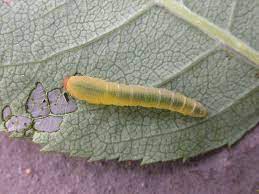
Rose Slug
Appearance: Rose slugs look like small green caterpillars. Adults are around 1/2 an inch long.
Origin: Rose slugs are native to North America.
Damage: Rose slug larvae feed on the undersides of rose leaves, leaving large holes behind.
Common host plants: Rose slugs feed on roses and other plants in the Rosaceae family.
Natural predators: Some natural predators of rose slugs are birds, parasitic wasps, and some species of beetles.
How to get rid of them: Handpicking and destroying the larvae is best when their numbers are small. Horticultural oils or insecticidal soaps can be used when there are many slugs.
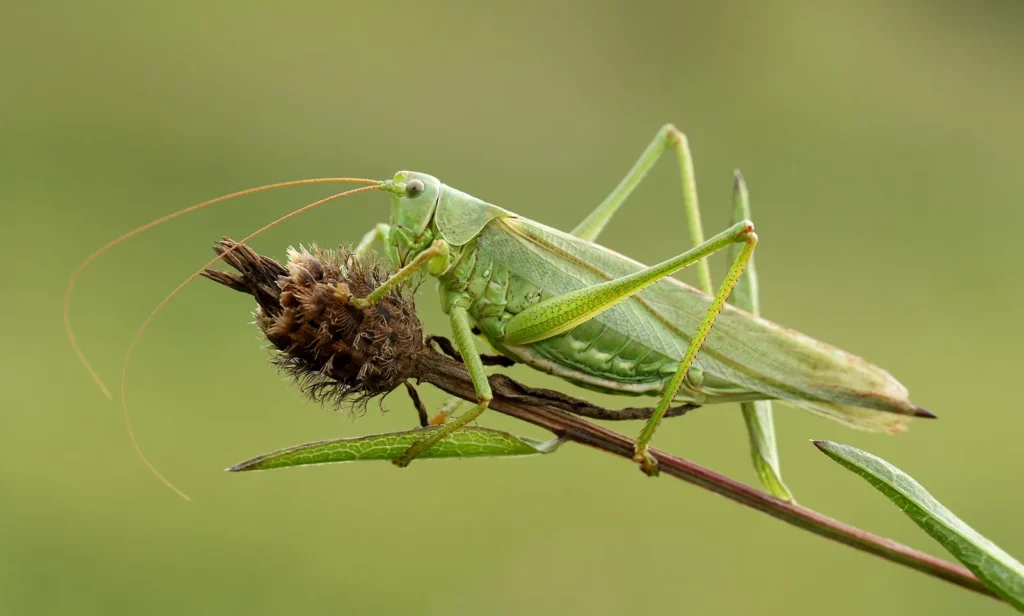
Grasshopper
Appearance: Grasshoppers are large, winged insects that can range in color from brown to green or yellow. They have long legs and antennae.
Origin: Grasshoppers are found throughout the world.
Damage: Grasshoppers chew ragged holes in the stems and leaves of plants.
Common host plants: Grasshoppers aren’t particularly picky and will eat almost anything, including grasses, vegetables (such as Asparagus), fruits, and ornamental flowers.
Natural predators: Birds, spiders, and some species of wasps and flies eat grasshoppers.
How to get rid of them: Small numbers of grasshoppers are no cause for alarm. They benefit the environment by being food for birds and other bugs. To prevent infestations, keep your weeds under control to limit their food supply. Applying garlic spray deters grasshoppers from feeding.
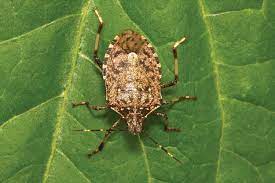
Stink Bug
Appearance: Stink bugs have shield-shaped bodies and are colored brown to black. They release a nasty odor when disturbed.
Origin: Stink bugs are native to Asia but they have recently found their way to North America.
Damage: Stink bugs consume fruits, leaving pockmarks on their surfaces and sucking the juices.
Common host plants: Their favorite fruits are apples, tomatoes, peppers, peaches, raspberries, blueberries, grapes, cucumbers, and hazelnuts, among others.
Natural predators: There are no natural predators for stink bugs in North America since they’re an invasive species.
How to get rid of them: Spraying kaolin clay solution onto your plants stops stink bugs from laying their eggs. Using companion plants like garlic, herbs, radishes, and marigolds deter stink bugs.
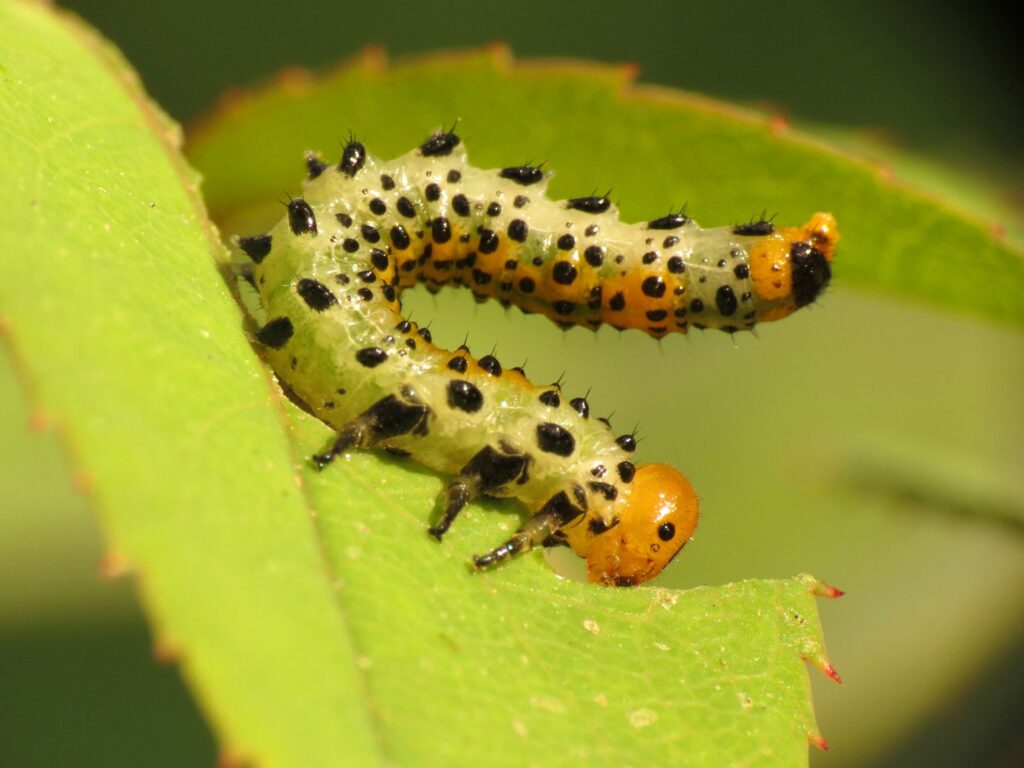
Sawfly Larvae
Appearance: Sawfly larvae resemble caterpillars. They are often green or brown and have multiple pairs of legs.
Origin: Sawflies are found throughout the world, especially in the northern hemisphere.
Damage: Coniferous-specific species can eat all the needles of a tree in a single year. Deciduous-specific species feed on tree leaves in a windowpane-feeding style.
Common host plants: Sawfly larvae feed on both coniferous and deciduous types of trees.
Natural predators: Birds, lizards, frogs, and ants all like to eat sawflies.
How to get rid of them: Handpicking sawfly larvae off plants and dropping them into a bucket of soapy water will help with small infestations. For larger infestations, neem oil or insecticidal soap can be used.
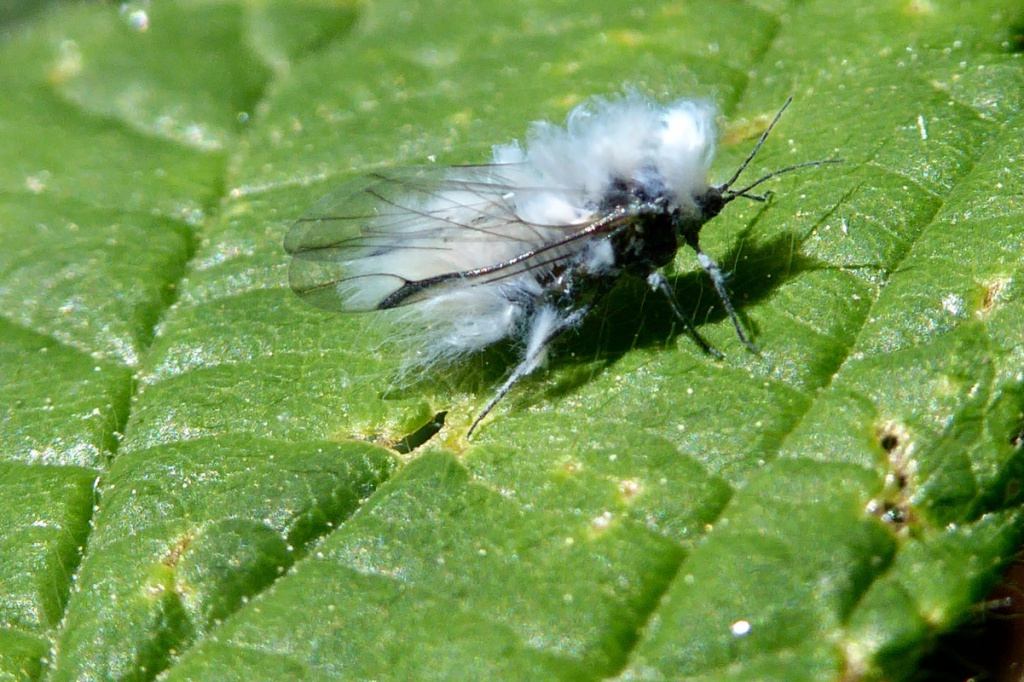
Woolly Beech Aphid
Appearance: Woolly beech aphids are small insects resembling aphids, but with a coating of wax that looks like pillow fluff.
Origin: Woolly beech aphids are native to Europe and have been introduced to other parts of the world.
Damage: Woolly beech aphids cause leaves to curl and wilt. They also leave behind honeydew, which attracts other pests.
Common host plants: As their name suggests, they primarily attack beech trees, but they can also be found on oak, maple, and elm trees.
Natural predators: Ladybugs, lacewings, hoverflies, and parasitic wasps are their natural predators.
How to get rid of them: They are best kept in check by their natural predators.

Earwig
Appearance: Earwigs are long, brown insects with antennae on their heads and pincers at the rear. They’re nocturnal and they move quickly, which makes them hard to spot.
Origin: Earwigs are found throughout the world, but are most common in warm, humid climates.
Damage: Earwigs chew holes in leaves and fruits. They also cause damage to seedlings by eating the emerging leaves.
Common host plants: Earwigs prefer to eat dead plant material, but they will switch to living plants if their numbers grow out of control. They attack vegetables such as lettuce and celery, as well as fruit trees, ornamental flowers, and seedlings.
Natural predators: Birds, toads, and ground beetles like to eat earwigs.
How to get rid of them: You can place pertoluem jelly around the stems to keep earwigs from climbing up. You can also make traps by mixing vegetable oil and soy sauce in a container and burying it up to the lid in the ground, with holes in the lid. The Earwigs will crawl through the holes and the oil will keep them from escaping.
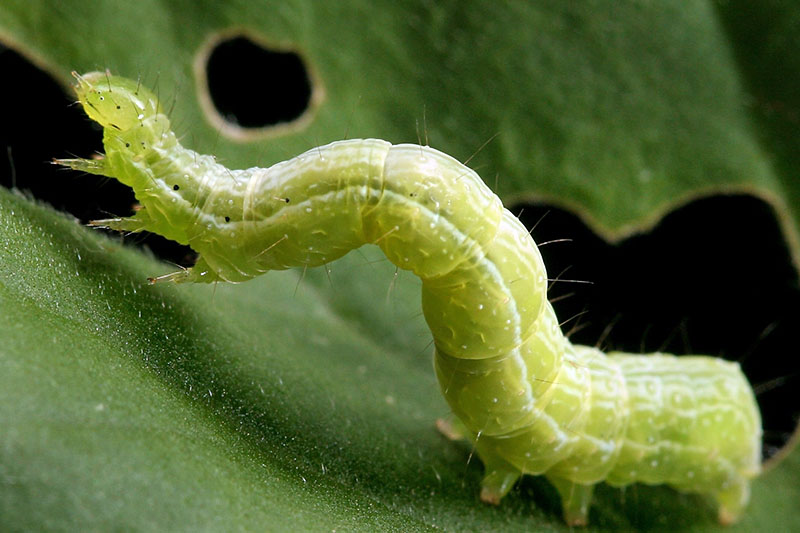
Cabbage Looper Caterpillar
Appearance: Cabbage looper caterpillars are green or brown with white stripes and measure about 1 inch in length.
Origin: Cabbage looper caterpillars are found throughout North America.
Damage: Cabbage looper caterpillars eat holes in the leaves of crops. They can also burrow into the heads of plants and damage the fruit.
Common host plants: Cabbage looper caterpillars feed on the brassica family of plants, which includes cabbage, broccoli, and cauliflower. They also attack other vegetable crops.
Natural predators: Birds, ground beetles, lady beetles, and spiders all make a snack of cabbage loopers.
How to get rid of them: Pick them off and place them in a bucket of soapy water. You can use row covers to prevent moths from landing on your plants. BTK sprays are an option that don’t harm bees or birds and are safe around pets and children.
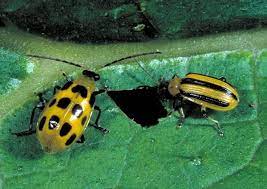
Cucumber Beetle
Appearance: Cucumber beetles are about 1/4 inch long and have a yellow-green body with black stripes or spots.
Origin: Cucumber beetles are native to North America.
Damage: Cucumber beetles feed on cucurbits such as cucumbers, pumpkins, and squash. They eat holes in the leaves and they also eat the fruits and flowers of the plants.
Common host plants: Cucumber beetles target cucurbits such as cucumbers, squash, and pumpkins.
Natural predators: Tachinid flies, wolf spiders, and ground beetles eat cucumber beetles.
How to get rid of them: Handpick and squish the beetles, and use row covers to prevent them from laying eggs on your plants. It’s thought that nasturtiums and wood ashes repel cucumber beetles.
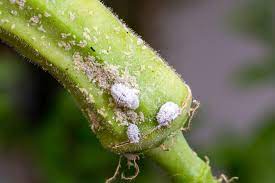
Mealybugs
Appearance: Mealybugs are white, oval-shaped bugs with many short legs and white, ribbed bodies. They are usually found on the undersides of leaves and in the nooks and crannies of plants.
Origin: Mealybugs are found throughout the world.
Damage: Mealybugs suck the sap out of the plants. They also transmit plant diseases.
Common host plants: Mealybugs target ornamentals, houseplants (such as Donkey’s Tail plants or Boston Fern plants), avocados, and fruits (like Lemon trees).
Natural predators: Ladybugs, lacewings, and parasitic wasps.
How to get rid of them: Use a cotton swab dipped in rubbing alcohol to kill the individual bugs. You can also use insecticidal soap or neem oil.
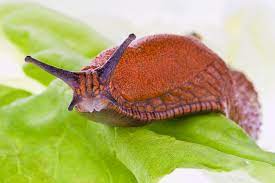
Slugs
Appearance: Slugs have long, slender, slimy brown bodies with no legs. They have a set of antennas on the head.
Origin: Slugs are found throughout the world.
Damage: Slugs feed on the leaves, stems, and fruits of plants. They leave jagged holes all over.
Common host plants: Slugs target a wide variety of plants, including lettuce, hostas, cabbage, tomatoes, and strawberries.
Natural predators: Birds, beetles, frogs and toads.
How to get rid of them: Not all slugs are bad – they help break down compost and act as food for other creatures. Only kill them when you find them on your garden crops. You can use a beer trap to lure and drown the slugs. You can also sprinkle diatomaceous earth around the plants, or use iron phosphate-based bait.
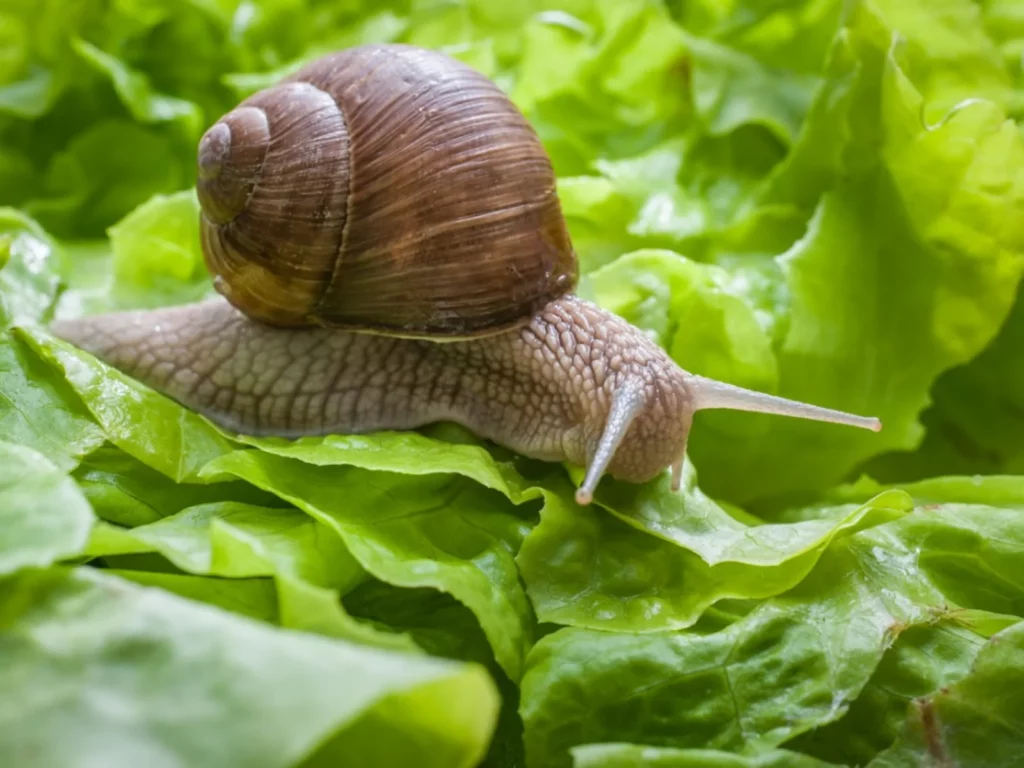
Snails
Appearance: Snails are similar to slugs in appearance but have a hard, spiral shell. They also have two tentacles on their heads, one of which has an eye on the end.
Origin: Snails are found throughout the world.
Damage: Snails feed on the leaves, stems, and fruits of plants. They leave jagged holes all over.
Common host plants: Snails target similar plants to slugs, such as lettuce, hostas, cabbage, tomatoes, and strawberries.
Natural predators: Birds, beetles, frogs, toads, and garter snakes.
How to get rid of them: You can use the same methods as with slugs. You can use a beer trap to lure and drown the slugs. You can also sprinkle diatomaceous earth around the plants, or use iron phosphate-based bait.
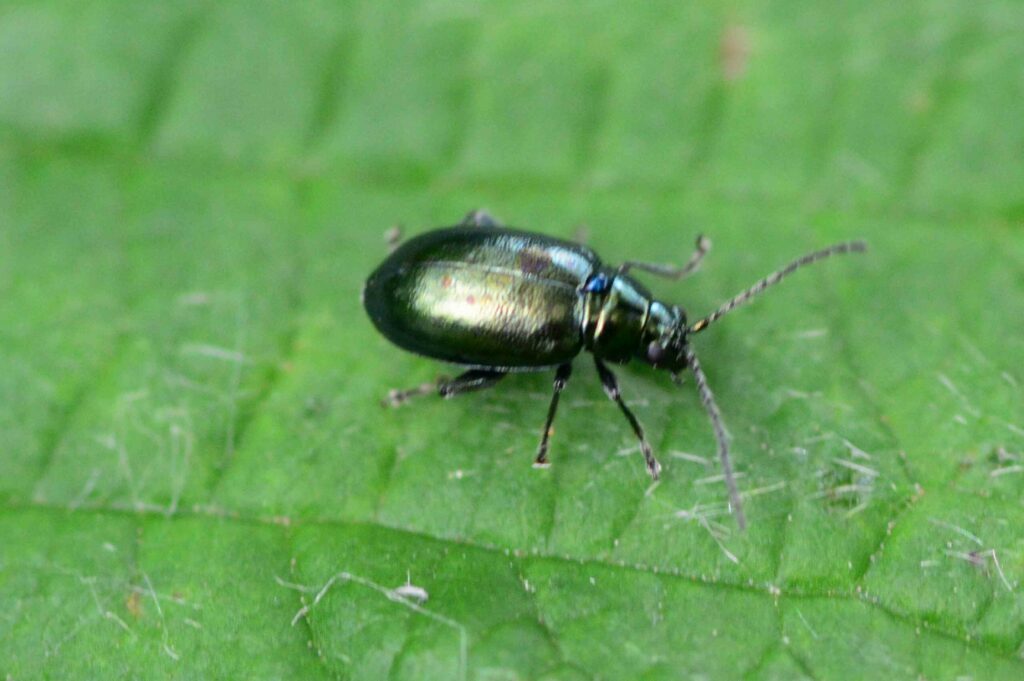
Flea Beetle
Appearance: Flea beetles have shiny black bodies with small heads and a set of antennas.
Origin: They’re found worldwide, most commonly in North America.
Damage: The beetles chew small holes in leaves and stems of plants, stunting their growth and leaving them vulnerable to other pests and diseases.
Common host plants: They attack a variety of plants, including vegetables like tomatoes, eggplant, radishes, spinach, onions, and jalapeños.
Natural predators: Birds, parasitic wasps, ground beetles, and toads.
How to get rid of them: To control flea beetles, try using insecticidal soap or neem
oil. Diatomaceous earth also works.

Potato Beetle
Appearance: The adult potato beetle is a bright yellow beetle with black stripes, while its larvae are reddish-brown with black heads.
Origin: They are native to North America, but are now found worldwide.
Damage: Both the larvae and adult beetles eat the leaves off of potato plants. They can defoliate your entire crop before harvest if not dealt with.
Common host plants: They are most commonly found on potato plants, but they sometimes attack other members of the nightshade family, like eggplant and tomatoes.
Natural predators: Stink bugs and lady beetles will eat potato beetle eggs. Unfortunately, natural predators offer little help in controlling potato beetles.
How to get rid of them: Watch for beetles when the plants first pop out of the ground. Check the undersides of leaves for bright orange eggs and squish them. They are immune to many pesticides but neem oil or Spinosad may work.
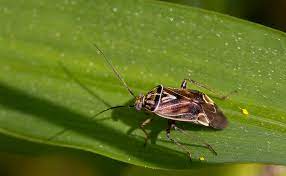
Tarnished Plant Bug
Appearance: Tarnished plant bugs are small, oval-shaped insects that are usually brown or green with yellow or red markings.
Origin: They are native to North America, but now found worldwide.
Damage: They prefer to feed on buds and flowers.
Common host plants: They feed on a variety of plants, including vegetables like beans, peppers, and tomatoes, as well as fruits like strawberries and raspberries.
Natural predators: Natural predators include birds, spiders, and parasitic wasps.
How to get rid of them: Control methods include using insecticidal soap or neem oil, pruning infested plant parts, and removing weeds around the garden to reduce the bug’s habitat.
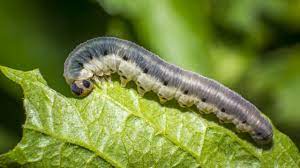
Cutworm
Appearance: Cutworms are the larvae of certain species of moths. They are C-shaped worms and are usually white or brown.
Origin: Found worldwide, most commonly in North America.
Damage: Cutworms cut plant stems off at the base, which topples the plant and kills it.
Common host plants: They feed on a variety of plants, including vegetables like tomatoes, peppers, and cabbage, as well as flowers like petunias and impatiens.
Natural predators: Natural predators include birds, parasitic wasps, and predatory beetles.
How to get rid of them: You can place a collar around the stems, which could simply be a clean tin can with both ends removed. If you see a cut down plant, the culprit is likely not far away – find it and kill it. Diatomaceous earth also works for cutworms.
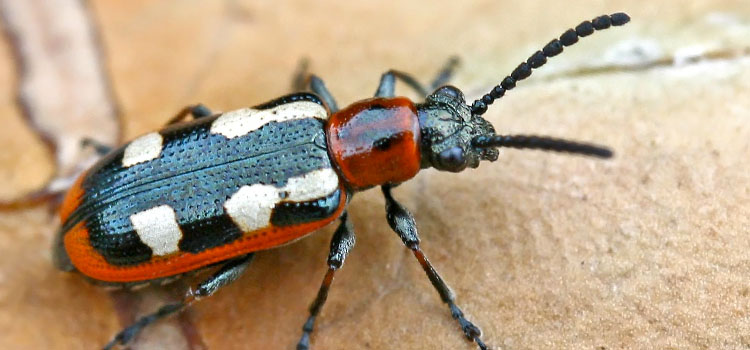
Asparagus Beetle
Appearance: Asparagus beetles are small, elongated insects that have patterns on their backs consisting of black, white, and red-orange shapes.
Origin: Native to Europe and Asia, asparagus beetles were introduced to North America in the late 1800s.
Damage: Adult beetles and their larvae feed on the asparagus spears all throughout the growing season. The spears wilt and droop down, giving them a hook-like appearance.
Common host plants: Asparagus is their primary host.
Natural predators: Natural predators include birds, parasitic wasps, and beneficial nematodes.
How to get rid of them: Remove and destroy any infected plant material. Handpick the beetles and their larvae – if you brush the larvae off the spear, they won’t be able to climb back up and will die on the ground.
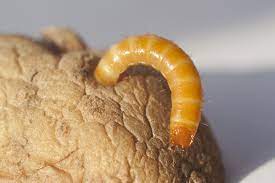
Wireworms
Appearance: Wireworms are slender, shiny, and reddish-brown worms which are about an inch to 1.5 inches long.
Origin: Wireworms are the larvae of click beetles and can be found worldwide.
Damage: Wireworms feed on the roots and underground stems of plants.
Common host plants: Wireworms attack a wide range of crops, including potatoes, carrots, beets, wheat, melons, onions, lettuce, strawberries.
Natural predators: Natural predators include birds, beetles, and other insects.
How to get rid of them: Rotate crops from year to year, work up the soil to expose the larvae to predators, and use insecticidal bait.
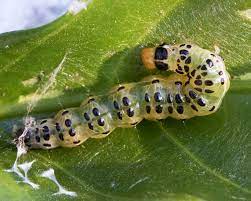
Leaf Roller
Appearance: Leaf rollers are small, green caterpillars that grow to about an inch long.
Origin: Leaf rollers are found worldwide.
Damage: A leaf roller will roll up a leaf and tie it with silk, creating a nest. They then feed on the leaves.
Common host plants: Leaf rollers attack shrubs and fruit trees, such as apple, pear, peach, and even coconut trees.
Natural predators: Natural predators include birds, parasitic wasps, and lacewings.
How to get rid of them: Handpick and destroy the rolled-up leaves. If the leafrollers are too numerous, use Bacillus thuringiensis (BT) spray.
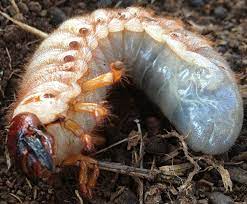
Beetle Grub
Appearance: Beetle grubs are white, C-shaped worms about 1 to 1.5 inches long.
Origin: Beetle grubs are the larvae of various beetle species, including the Japanese beetle and the June beetle.
Damage: Beetle grubs feed on the roots of plants.
Common host plants: Beetle grubs attack a wide range of plants, including grasses, ornamentals, and vegetables.
Natural predators: Natural predators include birds, moles, and parasitic nematodes.
How to get rid of them: Release beneficial nematodes, or use insecticide specifically formulated to kill beetle grubs.